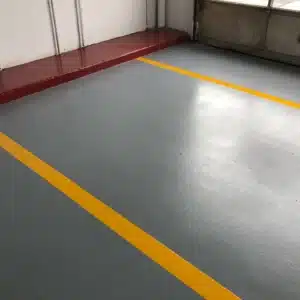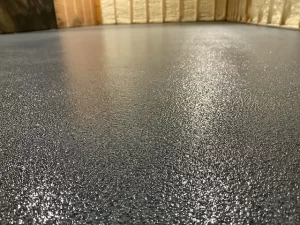Urethane Flooring: A Quick Overview
- What is it? Urethane flooring, also known as polyurethane flooring, is a durable and versatile option made from layers of polyurethane.
- Why choose it? It’s incredibly resistant to wear, tear, and various forms of damage, making it ideal for both industrial and commercial settings.
- Sustainability? Yes, it’s considered an environmentally friendly choice due to its longevity and the less frequent need for replacement.
- Best for? Perfect for areas with high traffic, chemical exposure, or those that require easy maintenance and cleaning.
In our quest for durable, cost-effective, and eco-friendly flooring solutions, urethane flooring emerges as a compelling choice. It aligns seamlessly with the needs of environmentally-conscious architects and builders. You’re looking for options that not only stand the test of time but also meet aesthetic and environmental standards without contributing to ongoing ecological challenges.
Urethane flooring, or polyurethane flooring, brings durability and sustainability to the forefront. These floors are designed to handle heavy traffic, resist chemical spills, and withstand extreme temperatures, making them ideal for various applications. From bustling commercial kitchens to sterile pharmaceutical labs, urethane floors provide a seamless, water-resistant surface that’s both easy to clean and maintain.
Moreover, their longer lifespan means less frequent replacement, minimizing waste and supporting sustainability goals. It’s a solution that offers peace of mind, knowing that choosing urethane flooring contributes positively to environmental sustainability while meeting the needs of today’s dynamic spaces.

What is Urethane Flooring?
When we talk about urethane flooring, we’re diving into a world where durability meets sleek design. This type of flooring is a superhero in areas that face tough challenges like heavy traffic, spills, and temperature swings. Let’s break it down into simpler terms to understand why urethane flooring, particularly Poly-Crete and cementitious urethane, is a game-changer.
Poly-Crete: The Strongheart
Imagine a floor that laughs in the face of dropped tools, scoffs at chemical spills, and doesn’t sweat under high heat or cold. That’s Poly-Crete for you. It’s not just any flooring; it’s a blend of cement, water, aggregate, and special additives that come together to form an incredibly tough surface. Its superpower? It forms a seamless bond with the base floor, leaving no nooks or crannies for dirt and bacteria to hide.
Cementitious Urethane: The Protector
Now, let’s talk about cementitious urethane. This isn’t your average floor coating. It’s a compound that brings the best of both worlds: the durability of cement with the flexibility and resistance of urethane. What does this mean for you? A floor that’s not only tough as nails but also water-resistant. Whether it’s a spill, a splash, or a flood, this flooring keeps water on the surface, making cleanup a breeze.
Seamless and Water-Resistant
One of the biggest fears with any flooring is the dreaded crack or seam where water can seep in and wreak havoc underneath. Urethane flooring eliminates this fear by creating a seamless surface. No seams mean no weak points for water to penetrate, making it an ideal choice for places like kitchens, bathrooms, and even industrial settings where water is a constant presence.
Why It Matters
In a nutshell, urethane flooring, particularly the types we’ve discussed, offers a fortress of protection against the everyday wear and tear that floors face. Whether it’s the constant foot traffic of a busy restaurant, the spills in a commercial kitchen, or the heavy machinery in an industrial plant, this flooring stands up to the challenge.
- Durability: It’s built to last, resisting everything from heavy drops to chemical spills.
- Chemical Resistance: Spills? No problem. Urethane flooring shrugs off chemicals without a second thought.
- Thermal Shock Resistance: Hot, cold, and everything in between, the temperature doesn’t faze it.
- Moisture Vapor Transmission: Humidity and moisture can’t penetrate its seamless surface, keeping the underlying floor safe and sound.
In flooring, urethane flooring is a true workhorse, combining strength, versatility, and ease of maintenance. Whether you’re outfitting a new space or upgrading an existing one, understanding the benefits of Poly-Crete and cementitious urethane can guide you to a decision that meets the demands of your environment head-on.
Keep in mind the unique properties of urethane flooring that make it stand out in the vast sea of flooring options. Its ability to withstand the rigors of high traffic, resist the damaging effects of water and chemicals, and maintain its integrity in varying temperatures makes it an unparalleled choice for both commercial and industrial applications.
Benefits of Urethane Flooring
When it comes to selecting the right flooring for your space, the benefits of urethane flooring are hard to overlook. Let’s dive into the key advantages that make urethane flooring a standout choice.
Durability
First and foremost, urethane flooring is incredibly durable. It’s designed to withstand heavy foot traffic, making it ideal for commercial kitchens, hospitals, and industrial settings. Unlike other flooring options that might wear out or get damaged easily, urethane flooring holds up remarkably well over time.
Chemical Resistance
In environments where spills are common, you need a floor that can handle it. Urethane flooring is resistant to a wide range of chemicals. This means that spills from oils, acids, and other substances won’t damage the floor. It’s a critical feature for places like laboratories and manufacturing plants.
Thermal Shock Resistance
Temperature fluctuations can wreak havoc on certain types of flooring. Urethane flooring, however, is built to withstand thermal shock. This makes it perfect for areas that experience significant temperature changes, such as commercial kitchens where hot water and cold water might spill on the floor regularly.
Moisture Vapor Transmission
Urethane flooring has a low permeability to moisture vapor. This characteristic is especially important in areas with high humidity or where the floor is exposed to moisture from below, like basements. It helps prevent the growth of mold and mildew, keeping the environment healthy and clean.
Easy Cleaning and Sanitization
Cleanliness is paramount, especially in healthcare and food preparation areas. Urethane flooring is seamless, which means there are no cracks or crevices where dirt and bacteria can hide. Cleaning is a breeze – a simple mop-up job will do. Plus, it can withstand harsh cleaning agents used in sanitization processes without deteriorating.
Sanitization
Speaking of sanitization, urethane flooring’s non-porous surface doesn’t allow bacteria and germs to penetrate. This is crucial for maintaining sterile environments in hospitals, clinics, and food manufacturing facilities. Regular cleaning routines will ensure these floors remain hygienic over time.
In summary, urethane flooring offers a combination of durability, chemical and thermal resistance, moisture control, and ease of maintenance that is hard to match. Whether you’re managing a high-traffic retail space, a busy hospital, or a large manufacturing facility, urethane flooring provides a reliable, long-lasting solution that will keep your operations running smoothly and looking great.
Understanding how to apply and maintain this versatile flooring will ensure you get the most out of its many benefits.
Epoxy vs. Urethane Flooring: Making the Right Choice
When it comes to choosing the right flooring for your commercial or industrial space, you’re likely to come across two popular options: epoxy and urethane flooring. Both have their merits, but depending on your specific needs regarding chemical resistance, temperature resistance, moisture resistance, strength and flexibility, texture, UV sensitivity, and installation time and costs, one may be more suitable than the other. Let’s break down these factors to help you make an informed decision.
Chemical Resistance
Urethane flooring stands out for its excellent chemical resistance. It’s built to withstand spills and stains from a wide range of substances, making it ideal for environments like laboratories or industrial settings where chemical spills can occur. Epoxy also offers good resistance, but urethane has the edge in environments with frequent or varied chemical exposure.
Temperature Resistance
For areas subject to extreme temperature changes, urethane flooring is the superior choice. It’s thermal shock resistant, meaning it can handle hot washdowns or cold storage conditions without damage. Epoxy can crack or delaminate under such stress.
Moisture Resistance
Both flooring types offer moisture resistance, but urethane’s seamless nature provides a slight advantage, especially in environments where spills are common or damp conditions prevail. It’s not just about resisting water on the surface; urethane prevents moisture from penetrating, protecting the subfloor as well.
Strength and Flexibility
Epoxy is known for its durability and strength, making it ideal for high-traffic areas. However, urethane’s flexibility under pressure allows it to absorb impacts without cracking or chipping, offering a longer-lasting solution in environments where the flooring may be subject to heavy machinery or constant foot traffic.
Texture
Both epoxy and urethane flooring can be customized in terms of texture for slip resistance. However, urethane offers a broader range of smooth to textured finishes, allowing for more customization based on safety requirements and aesthetic preferences.
UV Sensitivity
If your flooring is exposed to sunlight, urethane is the clear winner. It has high UV resistance, meaning it won’t yellow or fade over time. Epoxy, on the other hand, can show signs of aging when exposed to UV light.
Installation Time and Cost Comparison
Epoxy might seem less expensive upfront, but considering its shorter lifespan and annual maintenance costs, urethane flooring offers better long-term value. Urethane can be installed over a weekend, minimizing downtime, and it doesn’t require frequent replacements or touch-ups, making it more cost-effective over time.

In summary, while epoxy flooring has its advantages in terms of initial cost and strength, urethane flooring outperforms in flexibility, durability, chemical and temperature resistance, and long-term cost efficiency. For spaces that demand robust protection against chemicals, moisture, and temperature changes, and where long-term value is a priority, urethane flooring is the superior choice.
Understanding how to apply and maintain this versatile flooring will ensure you get the most out of its many benefits.
Disadvantages of Urethane Flooring
While urethane flooring boasts an impressive array of benefits, it’s important to consider a few disadvantages to make an informed decision. Let’s delve into the aspects of humidity sensitivity, gouging, and heavy industry traffic.
Humidity Sensitivity
First up, humidity sensitivity. Urethane flooring, despite its many strengths, does have a bit of a weak spot when it comes to environments with high humidity. During the installation process, excessive moisture in the air can affect the curing and adhesion of the urethane coating. This doesn’t mean it can’t be used in humid areas, but it does require careful planning and sometimes additional steps to ensure the flooring performs as expected.
Gouging
Next, let’s talk about gouging. Urethane floors are tough, but they’re not indestructible. Sharp objects can gouge the surface if enough force is applied. This is more of a concern in areas where heavy equipment or sharp tools might be dropped on the floor. While urethane flooring is more resistant to impacts than many alternatives, it’s still something to keep in mind, especially in industrial settings.
Heavy Industry Traffic
Finally, heavy industry traffic. Urethane flooring is designed to withstand a lot, but extremely heavy traffic, especially from machinery or vehicles with hard wheels, can wear down the surface over time. This doesn’t happen overnight, and urethane is still one of the more durable options on the market. However, in environments where heavy machinery is constantly in use, the flooring may show signs of wear sooner than expected.
Despite these disadvantages, urethane flooring remains a top choice for many due to its overall durability, resistance to chemicals, and ease of maintenance. Understanding these potential drawbacks helps in planning for the right flooring solution that meets all your needs, ensuring long-lasting satisfaction with your choice.
As we transition into how to apply and maintain urethane flooring, keep these considerations in mind. Proper application and regular maintenance are key to maximizing the lifespan and appearance of your urethane flooring, making it a valuable investment for years to come.
How to Apply and Maintain Urethane Flooring
Applying and maintaining urethane flooring doesn’t have to be complicated. With the right approach, your floors can look great and last longer. Let’s dive into the methods and tips that ensure your flooring stays in top shape.
Applying Urethane Flooring
Brush Application: Ideal for smaller areas or for edges where precision is crucial. Make sure to use a high-quality brush for an even application.
Wipe-Up Formula: This method works well for vertical surfaces or tight spots where control is essential to avoid drips or uneven coverage.
Rag Application: Good for touch-ups or smaller tasks. A clean, lint-free rag can be used to apply urethane in thin layers.
Spray Finishes: The best option for covering large areas efficiently. This requires specialized equipment and a bit of practice to master even coverage.
Maintaining Urethane Flooring
Daily Cleaning: Keep it simple. Sweep or vacuum regularly to remove dirt and debris. For spills, a damp mop is usually sufficient.
Deep Cleaning: Occasionally, you might need a more thorough clean. Use a mild detergent diluted in water, but ensure it’s compatible with urethane floors. Rinse well to avoid leaving residues.
Preventive Measures: Place mats at entrances to reduce the amount of dirt brought onto the floor. Use protective pads under furniture to prevent scratches.
Repairing Scratches: Small scratches can often be touched up with a matching urethane coating. For larger issues, it might be necessary to consult a professional.
Tips for Success
- Test First: Before using any new cleaning product or method, always test in an inconspicuous area.
- Avoid Harsh Chemicals: Strong solvents can damage the urethane finish. Stick to recommended cleaning solutions.
- Regular Checks: Inspect your flooring regularly for signs of wear or damage. Early detection can save time and money on repairs.
By following these guidelines for application and maintenance, you’ll ensure your urethane flooring remains durable and beautiful, serving your space well into the future. The key to longevity in flooring is not just in choosing the right material, but in caring for it properly after installation.
Frequently Asked Questions about Urethane Flooring
When it comes to selecting the right flooring, questions abound, especially regarding urethane flooring. Let’s dive into some of the most common queries to help clear the air.
What is the difference between epoxy and urethane flooring?
Epoxy and urethane flooring are often mentioned in the same breath, but they serve different purposes and have distinct characteristics.
- Epoxy flooring is known for its strength and chemical resistance. It’s a go-to for areas that need a tough surface that can handle spills and stains. However, it can be sensitive to UV light and may yellow over time.
- Urethane flooring, on the other hand, boasts flexibility and UV resistance, making it less likely to fade or yellow. It’s incredibly durable and can withstand extreme temperatures and heavy traffic, making it ideal for areas with high demands.
What are the disadvantages of polyurethane flooring?
Even the best flooring solutions have their downsides. For urethane flooring, a few points to consider include:
- Humidity Sensitivity: Urethane can be sensitive to humidity during application, which can affect its curing process.
- Gouging: While urethane is durable, it can be susceptible to gouging from sharp objects.
- Heavy Industry Traffic: In environments with extremely heavy machinery, urethane might show wear over time, though it’s still more durable than many alternatives.
Is urethane or polyurethane better for floors?
The terms urethane and polyurethane are often used interchangeably when it comes to flooring. Essentially, they refer to the same type of flooring solution, with polyurethane being the chemical name for what is commonly called urethane in industry parlance.
Both offer excellent durability, chemical and moisture resistance, and ease of maintenance, making them top choices for commercial and industrial spaces. The best option depends on your specific needs, including the expected traffic, exposure to chemicals, and the need for UV resistance.
By understanding these key points, you can make an informed decision on whether urethane flooring is the right choice for your space. It’s not just about choosing a flooring material but selecting one that will meet the demands of your environment and last for years to come.

Conclusion
Sustainable Design
When we talk about flooring, especially urethane flooring, it’s not just about picking a material that looks good or fits the budget. It’s about making a choice that supports a healthier planet. Urethane flooring stands out for its durability and longevity, which directly contribute to a more sustainable design approach.
Why does this matter? Well, floors that last longer mean we use fewer resources over time. Less replacement equals less waste. Plus, the seamless nature of urethane flooring makes it easier to clean and maintain, reducing the need for harsh chemicals that can harm the environment.
Topcoat Services
At Topcoat Services, we’re more than just a flooring company. We’re your partners in making choices that not only serve your immediate needs but also contribute positively to the world around us. Choosing urethane flooring is a step towards a sustainable future, and we’re here to guide you through every step of the process.
Our commitment to sustainability doesn’t stop at the products we offer. We strive to provide solutions that align with your goals for a greener, more eco-friendly space. Whether you’re upgrading a commercial kitchen, a high-traffic warehouse, or a bustling retail space, our urethane flooring options offer both the performance and the environmental consideration you’re looking for.
Choosing the right flooring is about more than just today. It’s about making a decision that will benefit your space, your budget, and the planet for years to come. Let us help you make a choice that you can be proud of, both for its performance and its impact on the world.
Discover more about our high-performance urethane flooring solutions and how we can help you achieve both your practical needs and your sustainability goals.









